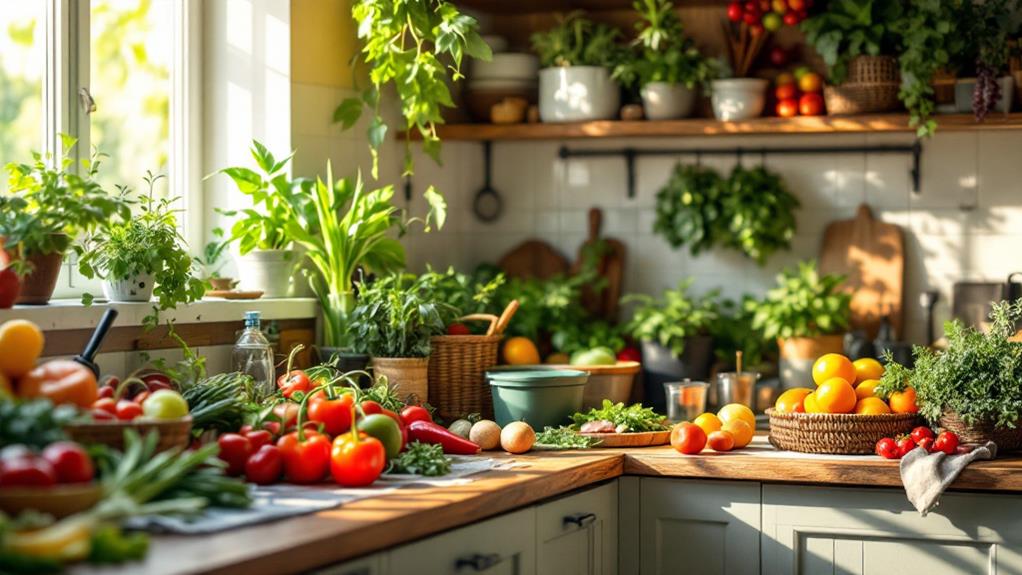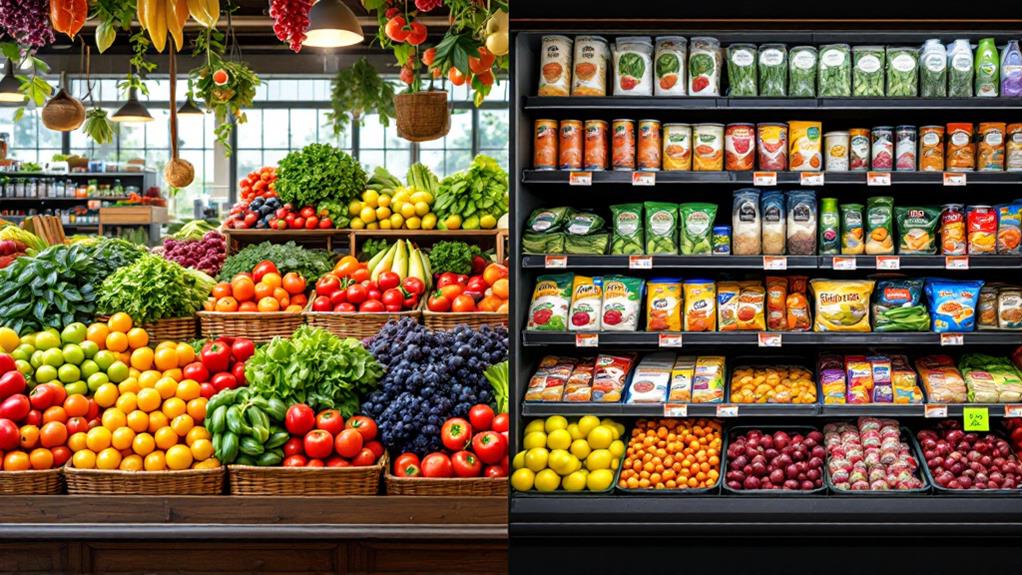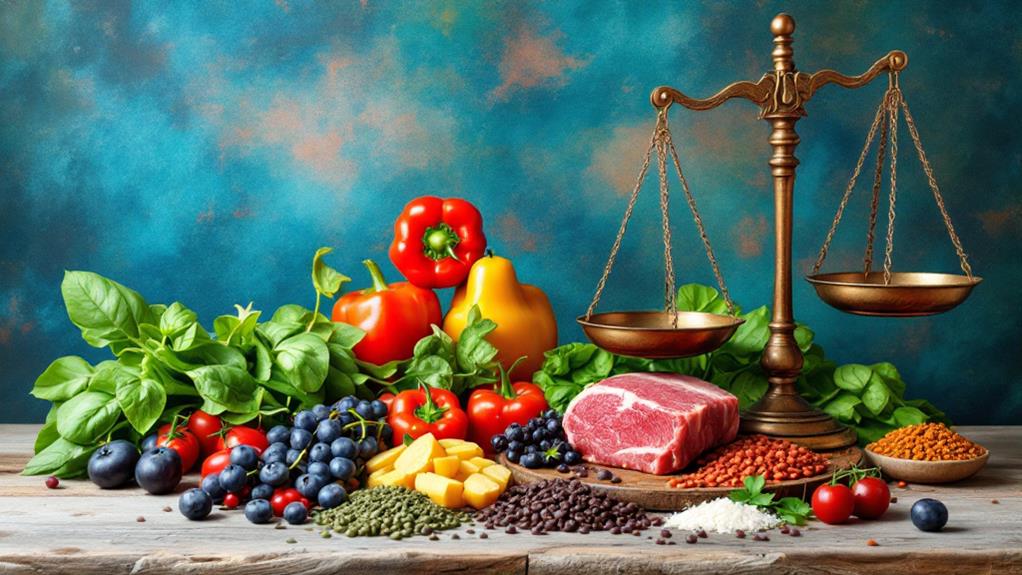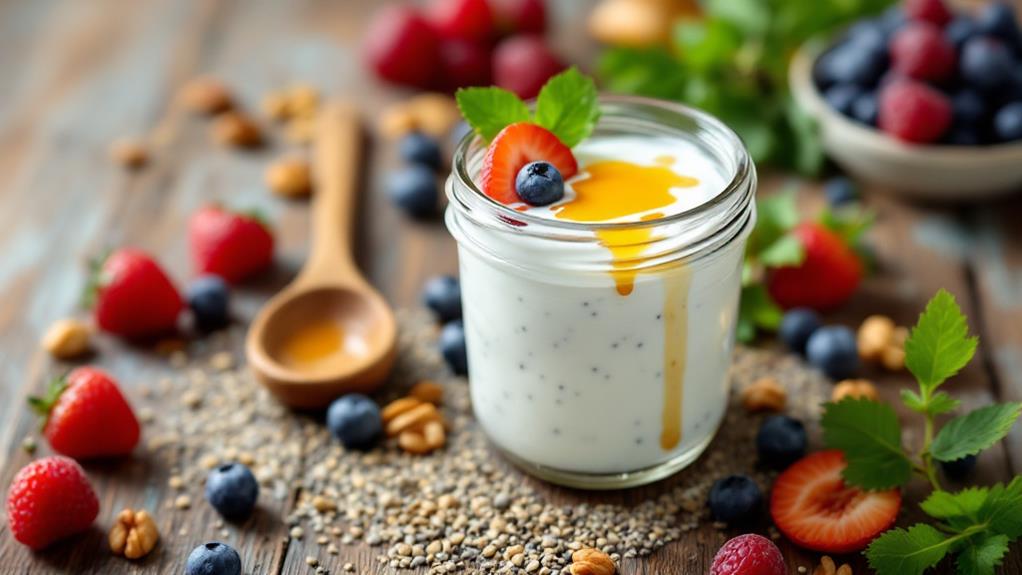The History of Food Dyes: How Colors Came to Your Plate
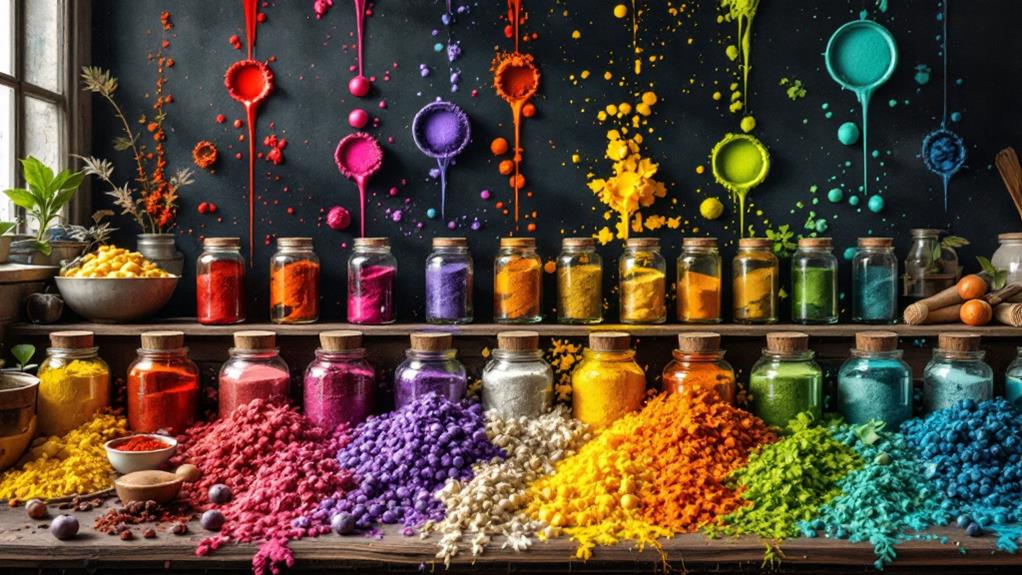
You might be surprised to learn that the colors in your food have ancient roots. Egyptians used natural dyes from plants and minerals as early as 1500 BC, while the Aztecs brightened dishes with cochineal red. Over time, synthetic dyes emerged with Perkin's mauve in 1856, leading to vivid and affordable options, but also health concerns. Early 20th-century regulations began enforcing dye safety, pushing a shift back to natural ingredients like turmeric and beet juice. Today's food coloring market is growing, driven by consumer demand for natural, safe, and sustainable options. Uncover the fascinating evolution of food dyes and their current innovations.
Ancient Origins of Food Coloring
Food coloring's roots stretch back thousands of years, with ancient civilizations pioneering its use for both culinary and textile purposes. The Egyptians were among the initial to accept natural dyes, extracting colors from plants and minerals as early as 1500 BC. They transformed ordinary meals into lively displays, setting a precedent for the importance of color in food presentation. You'd find the ancient Romans and Greeks also indulging in this practice, coloring their wines and foods to enhance the dining experience.
The Aztecs introduced the world to the vivid red dye made from cochineal insects, a practice that continues today. Saffron, a luxurious spice, was a popular choice for achieving a golden-yellow hue. This fascination with color didn't stop there. In Medieval Europe, the elite used lively colors to create visually appealing dishes, sometimes even naming them after their colors, like Golden Leeks.
As you investigate the history of food dyes, it's clear that the desire for visually appealing meals spurred trade and cultural exchanges. These interactions expanded the palette of natural dyes available, a proof of humanity's enduring quest to delight the senses through food.
Natural Ingredients and Methods
A multitude of natural ingredients have been used throughout history to create lively food colorings, each with its unique source and method. Unlike synthetic colors, these natural options offer not only visual appeal but also potential health benefits. For example, turmeric provides a deep yellow hue and is celebrated for its health-boosting properties, commonly found in mustard and curry dishes. Traditional dyeing methods often involve boiling plant materials with water and vinegar, a technique that has been passed down through generations.
Consider these natural ingredients for your coloring needs:
- Carotenoids from carrots: Perfect for achieving radiant orange shades.
- Anthocyanins from red cabbage: Ideal for creating striking blue colors.
- Beet juice: Soak eggs overnight for a deep red tint.
- Saffron: Used in ancient Mediterranean cuisines for a bright yellow touch.
Natural dyes typically require more time than synthetic ones to achieve the desired color intensity. Patience pays off when you let ingredients like red cabbage soak in a 2:1 water ratio for a brilliant result. These methods not only honor tradition but also enrich your meals with a touch of historical and cultural significance.
Emergence of Synthetic Dyes
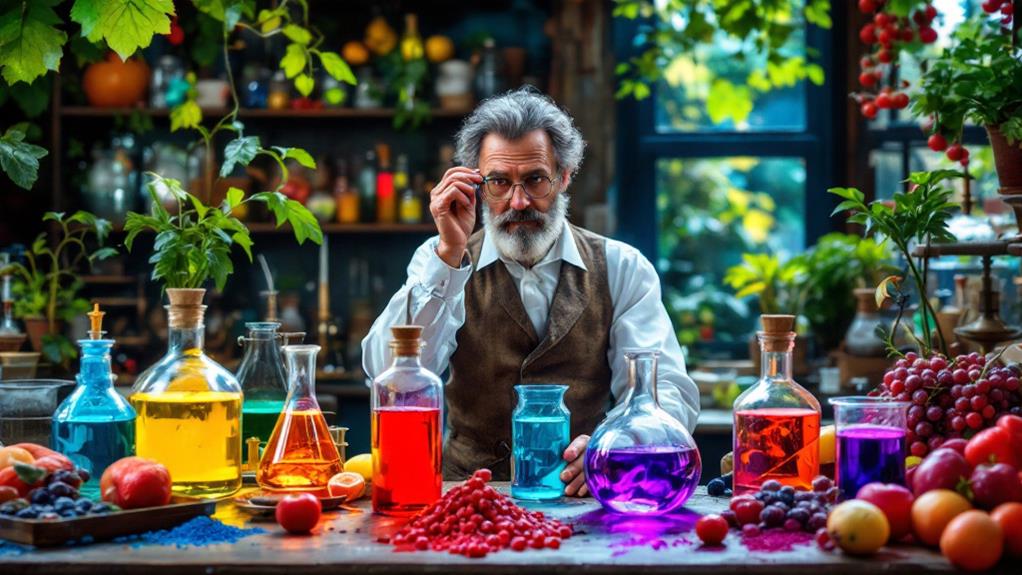
How did synthetic dyes revolutionize the way we color our foods? The expedition began with William Henry Perkin's revelation of mauve in 1856, sparking the synthetic dye industry. These artificial colors quickly found their way into food products by 1900, favored for their cost-effectiveness and lively hues over natural alternatives. Synthetic dyes offered a new palette for food colorants, drastically transforming how foods appeared on your plate.
However, the emergence of synthetic dyes raised significant public health concerns. Some early dyes contained harmful substances like lead and arsenic, posing health risks. This led to the 1906 Pure Food and Drugs Act, which prohibited the use of dangerous color additives and enforced stricter regulations on synthetic dyes in food. As a result, the industry had to adjust, ensuring that only safer dyes were approved for use.
Health Concerns and Incidents
Amid growing awareness of what we consume, synthetic food dyes have sparked significant health concerns. Synthetic food colorants have been linked to a range of health effects, especially hyperactivity in children. Studies like the Southampton Study (2007) highlighted how a mixture of six food dyes could increase hyperactivity, leading to legislative action in Europe requiring warning labels. Such findings have made many of you question the safety of food containing artificial food coloring.
Several adverse effects from synthetic dyes have led to historical bans. For instance, Orange #1 was prohibited in the 1950s following illnesses in children due to candy consumption, and Red #2 faced a ban in the 1970s over carcinogenic worries. These incidents remind us of the potential risks associated with color additives.
The Food and Drug Administration (FDA) continues to review and evaluate the safety of these additives. Here's what you should know:
- Red #40 and Yellow #5 are linked to hyperactivity concerns.
- Synthetic dyes can cause allergic reactions.
- California plans to ban Red 3 in food by 2027.
- Ongoing scrutiny of synthetic dyes highlights public health concerns.
As awareness grows, so does the call for safer, more transparent food choices.
Regulatory Milestones
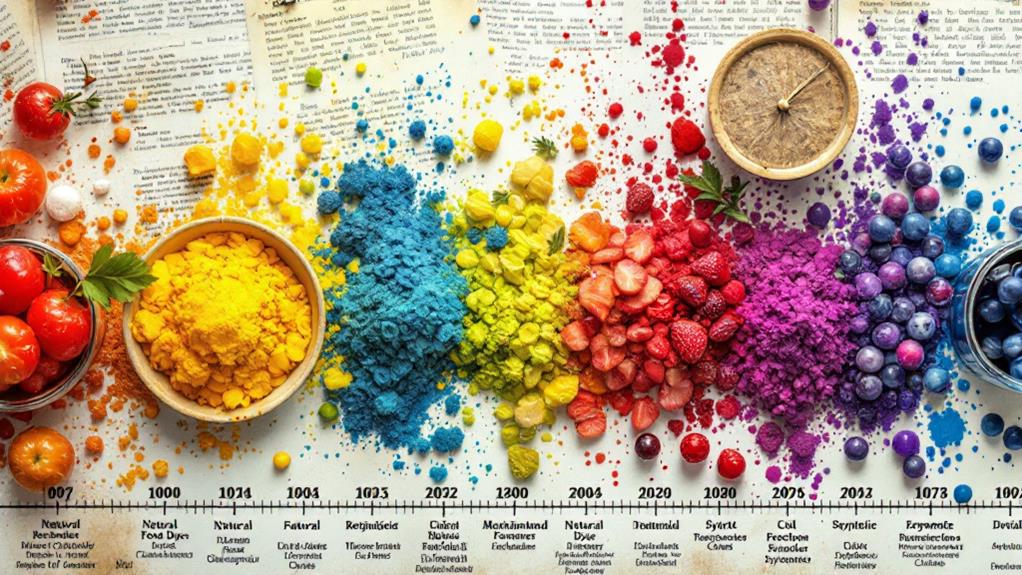
In the domain of food safety, regulatory milestones have greatly shaped the landscape of food dye usage. The expedition began with the Pure Food and Drugs Act of 1906, marking the initial federal move against harmful food additives. This act greatly impacted the use of color additives in the U.S. food supply, setting the stage for future regulations. When the Food and Drug Administration (FDA) was established in 1930, it further strengthened oversight through the 1938 Federal Food, Drug, and Cosmetic Act. This law expanded regulations, not just covering food but also cosmetics, imposing stricter controls on food colorings.
The 1960 Color Additive Amendments were crucial, introducing the Delaney Clause, which banned any color additive found to cause cancer in humans or animals. This led to the scrutiny and eventual ban of several synthetic dyes by the late 1970s, leaving only seven FDA-approved color additives for food products. On an international level, the Codex Alimentarius sets standards that influence regulatory practices worldwide, promoting safer food coloring options. Through these regulations, you can trust that the food colorings in your meals have undergone rigorous evaluations for safety.
Global Market Trends
Driven by evolving consumer preferences, the global food coloring market is seeing significant changes. You'll notice a surge in demand for visually appealing food products, projected to enhance the market from $4.6 billion in 2023 to $6 billion by 2028. With consumers leaning towards natural alternatives, the spotlight is on plant-based colors. These preferences are reshaping industry strategies, as companies ditch artificial dyes for more organic options.
This shift is partly due to regulatory differences across regions. For instance, Canada's specific maximum ppm levels and the EU's stricter standards compared to the U.S. influence how food colorants are formulated and marketed. Such disparities can complicate international trade but also drive innovation in the quest for compliant and appealing food additives.
Here are some key points to reflect on:
- Consumer preferences: A growing interest in natural and organic food colorants.
- Regulatory differences: Varying standards across countries impact market dynamics.
- Health awareness: Concerns over hyperactivity linked to artificial dyes drive demand for safer options.
- International standards: Global harmonization efforts aim to guarantee consistency and safety in food colorants.
You're witnessing a crucial moment where consumer health, regulatory frameworks, and market trends intersect, transforming the food colorant landscape.
Advances in Natural Colorants
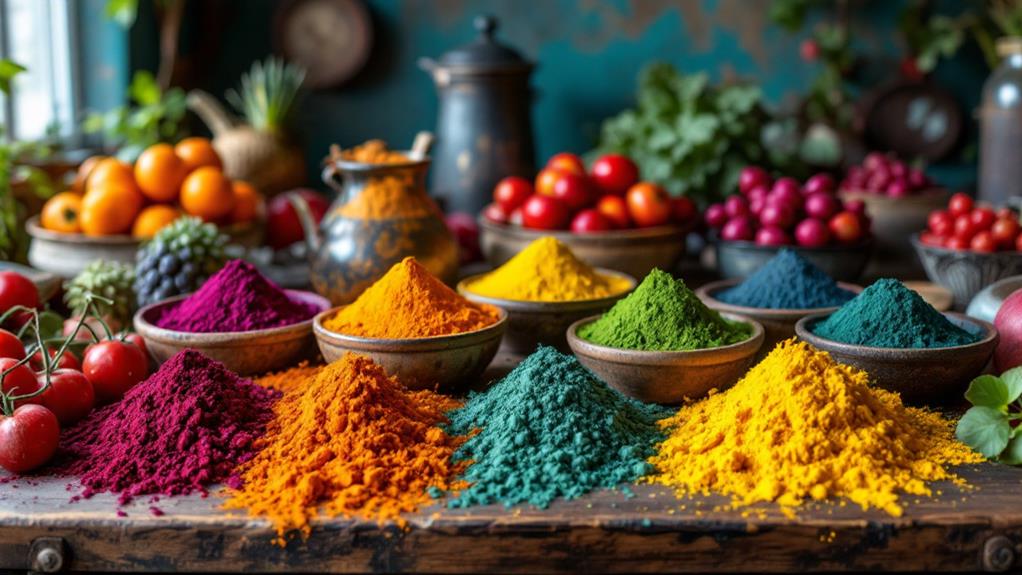
Someone with an interest in the world of food colorants will find the advances in natural options fascinating. Driven by consumer demand for transparency and healthier choices, the food industry is turning to plant-based dyes from sources like beetroot, turmeric, and spirulina. These natural colors not only cater to health-conscious consumers but also meet safety and regulatory standards that are increasingly stringent.
Technological innovations have played a significant role in this shift. Improved extraction and formulation methods boost the stability and brilliance of natural colorants, allowing them to compete with synthetic dyes. This progress means your lively red velvet cake or bright yellow curry can now be colored using ingredients that are as close to nature as possible.
As research continues, the potential of underutilized natural sources—such as diverse fruits, vegetables, and spices—is being investigated. This examination aims to expand the range of available colors without compromising on safety. Major food manufacturers are responding to the call for clean-label products by reformulating existing items, replacing synthetic dyes with natural alternatives.
Regulatory changes and heightened consumer awareness have also encouraged sustainable practices, making natural colorants an appealing choice for modern-day food production.
Future of Food Dye Innovations
Amidst a rapidly evolving food industry, the future of food dye advancements promises exciting developments. As consumer demand grows for visually appealing and creative food products, the market for food dyes is set to expand from $4.6 billion in 2023 to $6 billion by 2028. You'll notice a strong push towards natural color additives as advancements in food dye technology refine extraction and formulation methods, offering more lively and stable options.
The emphasis on transparency and health is driving a shift away from synthetic colors toward plant-based colorants. These alternatives are not only appealing for their natural ingredients but also align with the growing trend of sustainability in food production. The Viveri Food Colors Natural Red Food Color Challenge, for instance, is a proof of the industry's commitment to find safe substitutes for synthetic dyes like Red #40.
Here's what to watch for in the future:
- Enhanced natural color additives: Advancement in extraction techniques.
- Consumer-driven demand: Preference for transparency and health-focused products.
- Stricter regulatory standards: Ongoing research into health effects and safety.
- Rise of plant-based colorants: Meeting sustainability and transparency goals.
The future's looking brighter—and more colorful—than ever.

